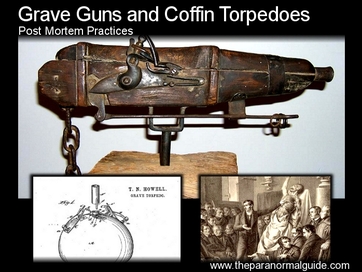
So reads the advertisement for a 'Grave Torpedo', a device that existed to thwart grave robbers.
Grave Robbers and Cemetery Ghouls
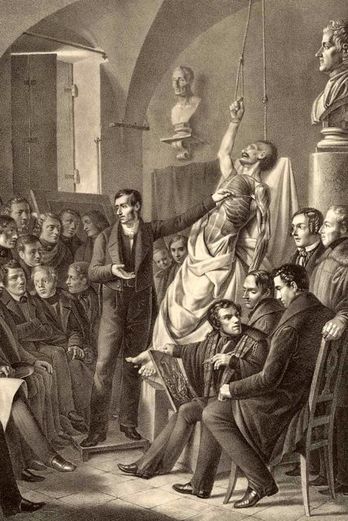 Fresh corpse utilised at a School of Anatomy.
Fresh corpse utilised at a School of Anatomy. During those years there was a huge demand for nice, fresh corpses. The schools of anatomy were largely about public examinations of bodies and their workings. Books on the subject were still quite primitive, a drawing could not capture the detail of inner human workings so dissections were carried out, and carried out in their hundreds, at times multiple dissections taking place in front of classes of hundreds of students, all vying for the best seats in the theatre.
It was quite lucrative for the schools as they could charge quite a pretty sum of money for entry into these displays of cutting, slicing, bending and snapping. There was more demand for these classes than could be met, so more bodies were always sought after.
Decrees were made stating that executed criminals would all be sent to the schools to have their insides brought to light, but there were nowhere near enough hangings to meet the demand. Some rather macabre people saw this niche had developed ,and soon began the time of the body snatchers – grave robbers who would seek out a fresh burial, dig it up and sell the body to the schools.
Public Outrage!
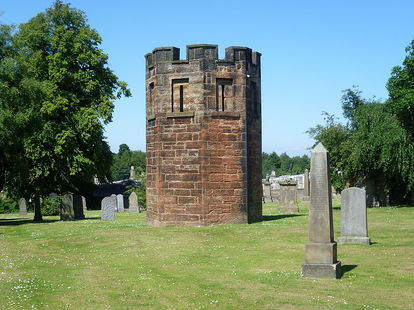 Cemetery watch tower.
Cemetery watch tower. People took matters into their own hands, set up groups to patrol cemeteries, erected watch towers, created safes and constructions of metal to surround coffins, and even built special houses to hold bodies till they had decayed sufficiently enough that they were no longer desirable for the grave robbers.
Unfortunately this was not always enough, the snatchers were quite wily and they found ways to bypass much of this security. Also at times these devices cost too much for the poor to buy or hire to keep their loved ones bodies safe. What was needed was a deterrent, something that would make a grave robber think twice about entering a cemetery to plunder graves.
Enter the invention of the Cemetery Gun.
Cemetery Guns
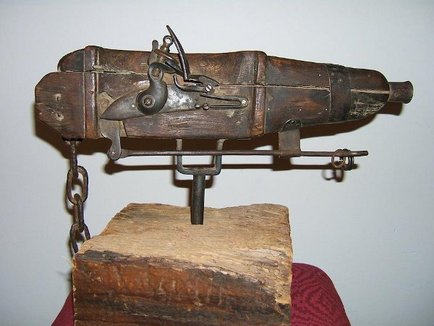 An example of a grave gun.
An example of a grave gun. Now wondering if the grave you sought to loot was booby trapped with a weapon capable of maiming or killing you, that was different!
A cemetery gun was a flintlock weapon that was mounted on a heavy block of wood some distance from a grave, or throughout the cemetery. A thin wire or string was attached to the trigger, and then led out from the weapon and set as a trip wire across paths and around the graves. Should the wire be disturbed, the gun would go off either with a blank charge serving as a warning device, an alarm, or the gun may be loaded with shot. If the would-be criminal was unlucky to be in front of the barrel, a world of pain could be expected.
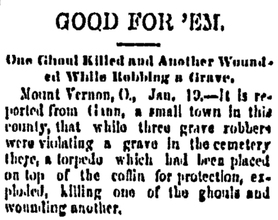 Report detailing the death of a grave ghoul.
Report detailing the death of a grave ghoul. It did not take too long for the grave robbers to wisen up to the situation and sent people, posing as mourners, to the sites to check out the situation, and to learn where the guns and other devices were located.
It was not just in Europe that body thefts were taking place. Once the Civil War came to an end in the United States, the number of medical schools began to rise, and with them the need for fresh cadavers. As with Europe, executed criminals were sent to the schools for dissection, however, just like Europe, the demand was greater than the supply. Purchasing bodies from grave robbers was not uncommon.
Coffin Torpedoes
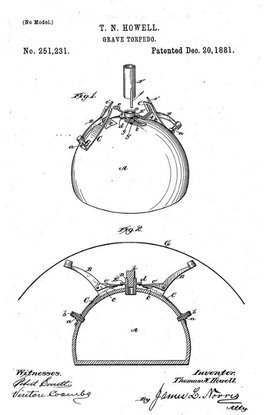 Plans for a grave torpedo.
Plans for a grave torpedo. Another invention was a device similar to a landmine. The device would lie in the dirt, just above the coffin lid. Should the dirt be disturbed, the device would detonate and blast anything above it. It was one such device that killed three men in Ohio, as they enjoyed a stroll through their local graveyard.
The devices do not celebrate the same popularity they once had, now mainly rusting relics sitting in museums or personal collections. Still, you never know what may lurk under the ground of an old grave. Maybe something to consider, for those who delight in the destruction of headstones.





 RSS Feed
RSS Feed
